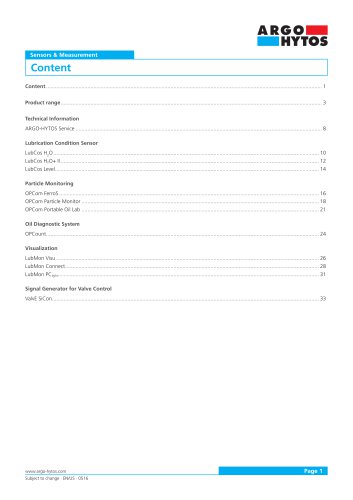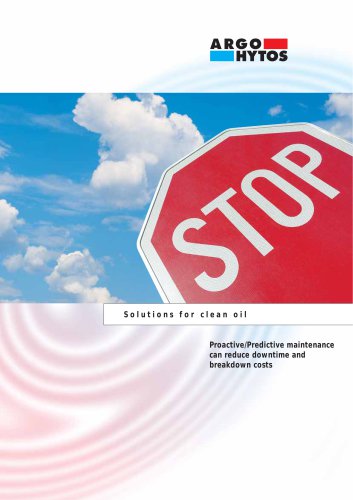 Website:
ARGO-HYTOS
Website:
ARGO-HYTOS
Group: Argo-Hytos
Catalog excerpts

optimal hydraulic filter
Open the catalog to page 1
Following the revision of several of the most mportant standards on assessing the perfor- mance of hydraulic filters and classifying oil cleanliness (ISO 4572 and ISO 4406), many users are now faced with the same question: what practical effects will these changes have? Let us answer this question immediately: in the future as in the past, the same filters in the same hydraulic systems will achieve the same levels of The changes only affect the presentation of the results from measurements. This new edition of the ARGO-HYTOS Guidelines on Selecting Hydraulic Filters includes many new...
Open the catalog to page 2
Our know-how - your benefit At ARGO-HYTOS, the focus is consistently on the customer - and a major element of our devel- opment work is to implement customer-specific solutions for filters and systems. Continuous improvement of our filter elements is another major goal of our development work: for example, this includes increasing the dirt capa- city while keeping the installed volume as smal as possible. This optimization goal is excellently achieved by our range of standard return-suction filters - just one example of many. Our sales engineers are just as reliable as our fil- ters...
Open the catalog to page 3
The key feature of the entire hydraulics sector is that - for understandable reasons - users are setting demanding (and ever increasing) require- ments for the quality and efficiency of the filters that are used. The testing technology used to develop filters must also meet these require- And this is where the difference between "filters" and ARGO-HYTOS filters emerges very ARGO-HYTOS operates testing rigs that are equipped with ultra-modern technology, enabling fast test sequences, extended testing procedures and accurate documentation of all the para- • Collapse/burst pressure test rig •...
Open the catalog to page 4
Oil cleanliness requirements are becoming stricter as time goes on. Filters are now expected to offer service lifetimes of 1,000 hours or more. Oils that stay clean not only extend the usual intervals between oil changes - they also prevent faults during operation, and they substantially extend the lifetimes of all the hydraulic components. Only in rare instances do we know how clean or dirty the pressure fluid in a hydraulic system really is. In many cases, the medium is only examined when a failure occurs or when damage is noticed. ARGO-HYTOS has developed its mobile customer service so...
Open the catalog to page 5
Guidelines on selecting the optimal hydraulic filter The selection procedure described below makes it easy for you to select the right filters for hydraulic To simplify matters, the procedure is broken down into these steps: • determine the right filter type • determine the filter fineness that is • determine the filter size that is • other considerations This filter selection procedure is based on many years of practical experience with countless mobile and industrial hydraulic systems that are equipped with correctly chosen ARGO-HYTOS Pressure filters proper filter type Unfortunately,...
Open the catalog to page 6
How to determine the proper filter type Suction filters Hydraulic systems have to be fitted with a suction filter if there is a particularly high risk of damage to the pump from coarse contamination. Typical applications of this sort include: • systems with a common oil reservoir for working hydraulics and gear transmissions. • units with oil tanks of large dimensions and/or complex shapes, or those which are welded or casted. Experience shows that 100 % cleaning of the tank prior to assembly is impossible under these • systems that are filled under difficult Often relatively coarse suction...
Open the catalog to page 7
How to determine the proper filter type Return filters It is particularly beneficial to use filters that are mounted on the tank or integrated in it, because this method allows filtering of the entire oil flow (full flow filtration) at low cost and with low space Full flow filtration in the return flow protects the pumps against dirt which penetrates the system from outside (especially via hydraulic cylinders) or which is generated by abrasion. When selecting the right filter size, it is essenti- al to consider the maximum possible flow rate. Depending on the area ratio between the piston...
Open the catalog to page 8
How to determine the proper filter type Return-Suction filters ARGO-HYTOS first developed its return suction filters in the mid-1980's. On equipment with a hydrostatic drive and combined working hydrau- ics, these filters replace the suction and/or pressure filters that were previously required for the filling pump of the closed hydrostatic drive, and in an open circuit they replace the return filter The benefit of these filters is that filtered oil is fed to the filling pump at an overpressure of 0.5 bar, avoiding the risk of cavitation in the filling pump so that excellent cold start...
Open the catalog to page 9
How to determine the proper filter type The main function of this type of filter is to ensure that the functions of downstream hydrau- ic components are protected. For this reason, these filters are installed directly upstream of the Taking account of the risks of dirt penetrating the system from outside and the possibility of pump abrasion, the following aspects can be particu- larly decisive for the use of a pressure or high- pressure filter: • the components are particularly sensitive to dirt (such as servo valves) and/or they are integral to the functioning of a complex • the components...
Open the catalog to page 10
How to determine the proper filter type • switching pressure of differentia The differential pressure which occurs here would ments, with a collapse pressure of 160 bar, have been specially developed to meet these demanding The EXAPOR®MAX 2-fiIter elements that are used in ARGO-HYTOS high-pressure filters without a bypass valve have a collapse pressure of 160 bar and they are stable in response to differentia pressure, so they satisfythe highest safety require- • damage to the filter layer up to the specified differential pressure of 160 bar is impossible thanks to the exceptional support...
Open the catalog to page 11All ARGO-HYTOS catalogs and technical brochures
-
MLS3-06
10 Pages
-
C5.3511 · C5.3516 · C5.3529
3 Pages
-
LS 040 · LS 075
6 Pages
-
ES 075
6 Pages
-
Catalogue Hydraulic Drives
65 Pages
-
Catalogue Fluid Management
69 Pages
-
MDA Highlights 2015
24 Pages
-
Solutions for clean Oil
6 Pages
-
Brochure for Endusers
2 Pages
-
Filtration Guideline
20 Pages
-
Light Line
4 Pages
-
Off-line Filtration
2 Pages
-
Agritechnica Highlights 2015
32 Pages
-
Catalogue Filtration
342 Pages
-
Catalogue Lightline
50 Pages
-
RC series
4 Pages
-
TS3 MTS2
6 Pages
-
TS4 MTS
6 Pages
-
ECOLINE
8 Pages
-
SR4P2-B2
4 Pages
-
SR1P2-A2
4 Pages
-
PRM7-10
10 Pages
-
PRM8-06
4 Pages
-
PRM2-04
20 Pages
-
PRM6-10
20 Pages
-
PRM7-06
10 Pages
-
PRM2-06
20 Pages
-
PRM7-04
10 Pages
-
Coils
18 Pages
-
Datasheet RPEL1-06
6 Pages
-
Datasheet RPH2-06
4 Pages
-
Datasheet RPR3-04
4 Pages
-
Brochure Wind Energy
2 Pages
-
EXAPOR MAX 2
3 Pages
-
Product summary
16 Pages
Archived catalogs
-
ARGO-HYTOS program summary
16 Pages
















































